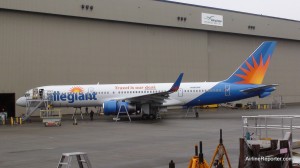
One of Allegiant Air's Boeing 757s (N902NV) at Everett, WA.
Allegiant Air, based in Las Vegas, is one of those wildcard airlines. One can never really know what they might do next and that keeps things very exciting. At a recent Low-Cost Airlines World Conference, Allegiant President Andrew Levy talked about the future of the airline, which might include international destinations and a loyalty program.
According to Aviation Week, Levy is “very excited” about the posibility of international growth. Allegiant is looking at the possibility of adding flights to Mexico and Canada via Las Vegas and Orlando.
Allegiant hopes to have a fleet of six Boeing 757s to supplement their fleet of MD-80 aircraft by the end of 2012. The airline has already announced the desire to start flights to Hawaii and Levy has noted that the aircraft would have the range to fly from Las Vegas to the northern area of South America. The Boeing 757s could also be used to fly to Mexico and add capacity on domestic routes.
It appears that Allegiant could see a use for more than just six Boeing 757s. ’œIf it’s as good an asset as we think it’s going to be for our network, we’ll certainly be buying a lot more,’ Levy stated at the conference. Levy will not yet estimate a number, noting that Allegiant doesn’t know how successful the six they already have will be.
When asked about the timeline of getting more aircraft and the additional routes, an Allegiant spokesperson stated they are “targeting” Hawaii for 2012, but there are no specific timelines for the international routes.
Levy also announced the airline is looking into a loyalty program, but it will be one not like other airlines. Instead of rewarding customers for the number of flights or miles flown, it would create loyalty for the entire Allegiant brand; online packages, hotels, rental cars, etc. ’œWe don’t need a loyalty program to get people to buy our air,’ Levy stated. ’œIf you’re in Des Moines, Iowa, and you want to go to Vegas, you’re going to buy our air. What we want you to do is buy the hotel, the car and maybe one day buy hotels in places that we don’t even fly.’
Allegiant is breaking the Ultra-Low Cost carrier mold of only having one aircraft type and looking to fly some longer international routes. I can’t wait to see what this little airline from Nevada might be able to
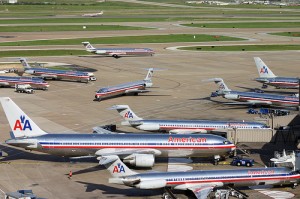
Always a lot of American Airlines' aircraft at Dallas/Forth Worth
I have flown a lot in my life, but I have never had a bag lost. I know I have been lucky. Talking to those who have been through it, I am glad I haven’t had to go through that.
Airlines have gotten better at not losing bags, but it still happens. American Airlines is testing out some pretty cool new technology to help bags get to their destinations and faster.
Each baggage vehicle has a computer screen which can tell workers flight status, gate changes and connections all in real-time. Workers also have hand-held computers to keep an eye on bags while away from the vehicle. At most airports, this is all done with paper, pencil and maybe a radio.
Right now, the technology is only being used at Dallas/Fort Worth International Airport. Hopefully it will be rolled out to other airports and adopted by other airlines if successful. Let’s also hope this new technology can stop bags from having unknown fluids spilled on them!
connect | web | twitter | facebook |
Source: NBCDFW Image: coneinc
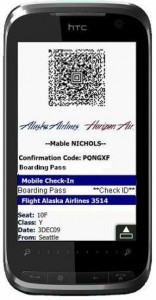
Electronic boarding passes are probably the future of airline travel. Image from Alaska Airlines.
The future is nearing. A little over a year ago I talked about electronic boarding passes becoming a reality. Today, Alaska Airlines and Horizon Air are launching both a mobile-friendly website and electronic boarding passes for passengers flying from Anchorage, Boise, Denver, Las Vegas, Portland, Seattle and Spokane. There are already 30 airports and six airlines testing out this technology: Continental, Delta, Alaska, Horizon and American. Surprisingly, Alaska and Horizon are the first non-legacy airlines to test out the new technology.
Travellers are able to check in using their mobile phone up to 24 hours in advance of their flight. They are given an encrypted barcode along with the passenger and flight information. While going through security, TSA will be able to scan the electronic ticket, check id and the passenger is good to go.
“Alaska Airlines and Horizon Air’s electronic boarding pass and optimized mobile Web site meet the needs of today’s high-tech traveler, ” said Steve Jarvis, Alaska Airlines’ vice president of marketing, sales and customer experience. “Starting today, our customers can expedite the airport check-in process even more and get from curbside to planeside in record time.”
In the next few months, the service will be spread to other Alaska and Horizon cities. In the future, they told me we, “will see more mobile device enhancements to make travel more convenient.”
Is this the future of airline travel? I really think so. No more having to double check to make sure you have your boarding passes. No more having to track down a departure screen to see what your flight status is. The biggest problem will be remember to charge your phone before leaving. Nothing would be more frustrating than waiting in security for 30 minutes, have your phone die, having to go wait in line to get your boarding pass, then get through security again.
Personally, I haven’t been able to test out this new technology. Have any of you been able to? What are your thoughts?
connect | web | twitter | facebook |
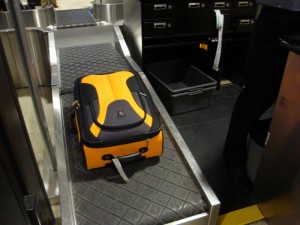
The test bag, at Alaska Airlines baggage check counter at Seattle-Tacoma International Airport, ready to start its journey to Phoenix
One of my least favorite parts of flying is waiting for my bag in baggage claim. First you wait to see which carousel your bags will come out on. Then you wait for them to change the carousel number. Then you get excited when the lights flash and the conveyor belt starts moving, but normally you are waiting a bit more until bags come out. Sometimes you are lucky and your bags come off the conveyor belt early, but other times, it can take upwards of an hour to get all your luggage (if they show up at all).
Alaska Airlines currently has a promotion that is changing the game. If you do not get your checked bags with-in 25 minutes of your flight reaching the gate, you will get a $25 discount code for a future flight on Alaska Airlines or Horizon Airlines or you can choose to get 2,500 Mileage Plan bonus miles.
I wanted to check-in on how the promo was going and talked to Greg Latimer, who is the Managing Director of Brand and Product Marketing for Alaska Airlines. He explained that the airline checks about 20,000 bags per day and since the start of this promo on July 7th only a few hundred certificates have been claimed. He admitted that not that long ago, Alaska Airlines wouldn’t have been able to complete the task of getting all checked bags to customers in 25 minutes, but they have been working hard and are proud of their accomplishment.
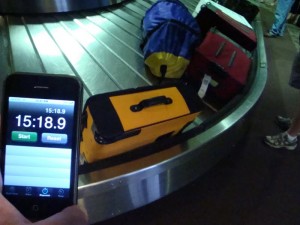
It took less than 15:18 for the bag to be ready for pick-up in Phoenix, but it took me that long to get the baggage claim.
The promotion and stats looked great on paper, but I wanted to put this to the test. It was good timing. I was heading from Seattle, WA to Phoenix, AZ this weekend and flying on Alaska. It was only for a few days and normally would have just carried on my bag, but it was worth the $15 to check a bag and find out if Alaska could deliver on this guarantee. I had no problems checking my bag at Seattle-Tacoma International Airport. I decided to go with an orange bag (actually a friend’s bag who was traveling with me, but mine was a boring black one) to track its journey.
The flight went great (except there was no Skymall magazine in the seatback…so I couldn’t see the new gadgets) and landed almost on time. Once we pulled up to the gate at Phoenix International Airport, I started the timer. I was flying back in row 26, so it took me a while to get off the plane, but the terminal is small and I went quickly to make sure I got there before the 25 minute mark. By the time I got to baggage claim, there was the orange bag, already out, making the rounds. It was only 15:18 when I saw the bag. I am not going to lie, I was very impressed. So few times have I flown and had my bag waiting for me on the carousel.
This policy just makes sense. With airlines charging to check bags (Alaska Airlines charges $15 for 1st bag and $25 for second), it seems silly passengers should have to wait so long to get their bags. Instead passengers will bring carry-ons causing issues with space and slowing down the security process (took me 35minutes to get through security and I had no carry-ons, but 99% of everyone else did). Ladimer told me they aren’t sure what Alaska is going to do after this promotion expires on December 31st. I know it might not be sustainable to offer $25 of 2,500 miles for the long term, but I really hope they can keep up the guarantee in some fashion. I am optimistic that other airlines might follow suit and make a better effort in the speed at which they have bags ready for pick-up. I personally know I am much more likely to pay for a checked bag if I know my bag will be there quick.
UPDATE 01/01/10: Alaska tells me they have extended this deal until at least July 31, 2010.
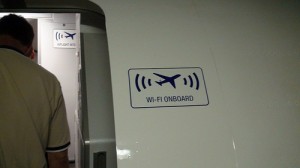
The sign outside of my first Wi-Fi flight back in May.
Yes! I am coming out and predicting that someday Wi-Fi will be free on at least some airlines. I am not talking first class or business class; I am talking about free Wi-Fi for the entire plane. Let me explain…
Southwest Airlines is the newest airline to announce adding Wi-Fi to their flights. Many other airlines already have some or all of their fleets wireless. It took the industry a long time to start becoming wireless, but now almost all US airlines have at least a few Wi-Fi equipped aircraft. The rapid growth shows capitalism at its best. When one airline has Wi-Fi, it provides an obvious advantage over those that do not. However, when almost all airlines in the United States have Wi-Fi, where does one airline stand out over another?
Think about long-distance on landlines (you remember those, right; where wires connected your phone calls?). It used to be mighty expensive to call based on time of day, then there were flat rates per minute, then you could just pay a monthly fee and call whenever and whomever you wanted. The same phenomenon happened with cell phones. Minutes used to be costly, now companies have plans with unlimited minutes, rollover minutes, etc. As competition grows, so do the benefits for the customer.
With Wi-Fi on the airlines, it is a bit more complicated; airlines don’t run the Wi-Fi, independent companies do. Some airlines like American, Delta, and AirTran are using Aircell’s GoGo tower-based Wi-Fi service, but Southwest is using Row44, which is a satellite-based system. Either way, Wi-Fi companies are competitive businesses that have to charge the airlines, so the airlines would need to absorb the costs to provide free Wi-Fi.
I know, with airlines charging fees for everything today, why would an airline ever be willing to absorb the costs? I think we are in a unique time. I don’t expect all these fees to be around forever (at least I hope not). All it would take is one airline. One airline to announce they have free Wi-Fi. It might be years from now when this happens, and it might take a few more years for other airlines to follow. However, this is how things have become cheaper and free in the past. With so many airlines in the US, it is feasible that one might want to come across as a “high-tech”, “medium frills” airline.
Hopefully I am right in this one, but if I am not, I am still willing to pay $13 to access the internet on a flight!





